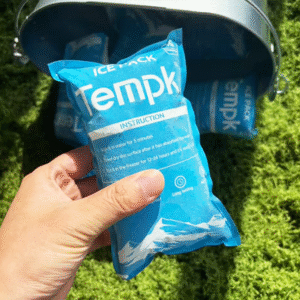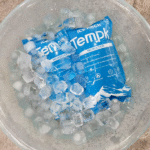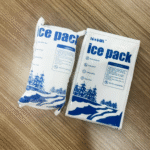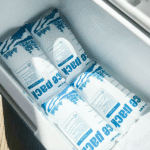Cara Mengemas Paket Es Kering untuk Pengiriman Masuk 2025?
Perkenalan: Mengemas paket es kering dengan benar sangat penting untuk menjaga kondisi beku atau sangat dingin selama transit. Yang pertama 50 kata-kata, perhatikan bahwa artikel ini menjelaskan caranya paket paket es kering untuk melindungi barang-barang yang mudah rusak seperti vaksin dan makanan laut. Es kering menyublim pada –78,5°C, jadi kemasan Anda harus mengeluarkan gas karbon dioksida untuk menghindari peningkatan tekanan. Panduan ini menggunakan bahasa yang jelas dan contoh dunia nyata untuk membantu Anda mengirim dengan percaya diri.
Mengapa pengemasan es kering yang tepat itu penting – mencakup faktor-faktor seperti wadah berventilasi dan pra-pembekuan untuk melindungi barang.
Cara menghitung dan melapisi es kering – termasuk perkiraan berat dan penempatan “sandwich” untuk meningkatkan retensi dingin.
Persyaratan peraturan dan pelabelan – dari penandaan UN1845 hingga kelas 9 label bahaya.
Pilihan kemasan modern – membandingkan panel VIP, Busa EPS dan bahan pengubah fasa untuk biaya, kinerja dan keberlanjutan.
2025 tren dan inovasi – menyoroti sensor pintar, ketertelusuran blockchain dan sistem es kering yang dapat digunakan kembali.
Mengapa Pengemasan Es Kering yang Benar Penting?
Pengemasan yang tepat memastikan pengiriman beku tiba pada suhu yang tepat dan risiko keselamatan diminimalkan. Es kering adalah karbon dioksida padat dan menyublim langsung menjadi gas, jadi wadah kedap udara bisa pecah karena tekanan yang meningkat. Desain dan insulasi berventilasi menjaga muatan tetap dingin sekaligus memungkinkan gas keluar. Pengemasan yang efektif juga mengurangi produk yang terbuang dan pengiriman pengganti, menghemat waktu dan uang.
Selain melindungi produk, pengemasan yang benar diwajibkan oleh regulator. AS. Departemen Transportasi (DOT) dan Asosiasi Transportasi Udara Internasional (Iata) mengolah es kering (Dan1845) sebagai bahan berbahaya, mewajibkan label dan jumlah maksimum per paket. Kegagalan untuk mematuhi dapat menunda pengiriman atau mengakibatkan penalti. Oleh karena itu, kemasan berkualitas memiliki manfaat kepatuhan dan operasional.
Kemasan Melindungi Kualitas dan Mengurangi Limbah
Saat es kering menyublim, ia menyerap panas dari lingkungan dan mempertahankan suhu rendah. Paket yang kuat berfungsi seperti termos, mengurangi perpindahan panas dari lingkungan. Studi menunjukkan bahwa wadah busa dengan panel berinsulasi vakum (VIP) sisipan dapat mempertahankan suhu hingga 96–240 jam, mengurangi massa es kering sebesar 20–40%. Hal ini tidak hanya menjaga kualitas produk tetapi juga menurunkan berat dan biaya pengiriman. Sebaliknya, kemasan yang insulasinya buruk atau kedap udara menyebabkan sublimasi cepat, menyebabkan lonjakan suhu dan potensi pembusukan.
| Manfaat Utama | Bukti | Apa Artinya bagi Anda |
| Mengurangi pembusukan | Pelapisan yang tepat (“blok dasar + sisi + pelet atas”) mengurangi kantong hangat, mengurangi kegagalan pengiriman sebesar 38% dalam studi kasus perusahaan kue. | Lebih sedikit pengembalian uang dan pelanggan lebih bahagia. |
| Biaya lebih rendah | Panel VIP memungkinkan waktu tahan lebih lama dengan lebih sedikit es kering, mengurangi berat pengiriman dan biaya volumetrik. | Penghematan biaya pengiriman dan konsumsi es kering. |
| Kepatuhan Pengaturan | Label yang menunjukkan “Es Kering/Karbon dioksida, padat,” UN1845 dan berat bersih wajib untuk pengiriman udara. | Menghindari denda dan memastikan kelancaran penerimaan di konter operator. |
Kemasan Mempengaruhi Keamanan
Es kering sangat dingin (–109,3 °F), jadi menyentuhnya tanpa perlindungan menyebabkan radang dingin seketika. Kenakan sarung tangan dan kacamata berinsulasi saat menangani es kering, dan gunakan penjepit untuk menghindari kontak yang terlalu lama. Pengemasan yang tepat harus mencegah kontak langsung antara es kering dan makanan; menggunakan pembatas atau kompartemen tersendiri agar konsumen tidak terkena sisa es kering. Selain itu, membiarkan ventilasi terbuka mencegah penumpukan karbon dioksida, mengurangi risiko ledakan dan mati lemas.
Bagaimana Cara Memilih Kemasan yang Tepat untuk Es Kering?
Memilih kemasan yang tepat melibatkan evaluasi persyaratan suhu produk, durasi pengiriman dan konteks peraturan. Mari kita jelajahi faktor-faktor utamanya.
Pertimbangkan Sensitivitas Suhu dan Durasi Pengiriman
Produk seperti vaksin seringkali memerlukan suhu yang sangat rendah (–20 °C hingga –70 °C). Dalam kasus ini, es kering memberikan pendinginan yang andal karena ia mempertahankan suhu di bawah titik beku selama 24–72 jam. Pedoman umum adalah 5–10 pon es kering per 24 jam untuk setiap 10–15 pon produk. Waktu transit yang lebih lama atau muatan yang lebih besar memerlukan lebih banyak es kering dan insulasi yang lebih tebal. Tabel di bawah ini merangkum kebutuhan-kebutuhan umum.
| Jenis Pengiriman | Jumlah Es Kering (pon per 24 H) | Lamanya (jam) | Kisaran suhu | Arti Praktis |
| Farmasi | 5–10 | 24–72 | –20 °C hingga –70 °C | Obat-obatan yang sangat dingin seperti vaksin memerlukan es kering yang berat. |
| Hidangan laut | 1–2 | 24 | –18 °C hingga –20 °C | Beban yang lebih ringan sudah cukup; hindari pembekuan yang berlebihan. |
| Sampel biotek | 5 | 48 | –20 °C hingga –50 °C | Cukup untuk menjaga perangkat sensitif tetap stabil. |
| Makanan beku | 2–3 | 24 | –10 °C hingga –18 °C | Membutuhkan es kering sedang untuk pengiriman bahan makanan pada umumnya. |
Jika produk Anda harus tetap didinginkan (2 °C–8 °C), bahan perubahan fase (PCM) bungkus atau bungkus gel mungkin lebih aman karena es kering berisiko membekukan isinya. Untuk pengiriman yang memerlukan pendinginan dan pembekuan dalam paket yang sama, solusi hibrida dengan PCM dan es kering dapat mempertahankan beberapa zona suhu.
Cocokkan Isolasi dengan Waktu Transit
Isolasi memperlambat laju sublimasi es kering dan panas masuk ke dalam kemasan. Pendingin busa terbuat dari polistiren yang diperluas (EPS) umum untuk 24–Pengiriman 48 jam. Meningkatkan ke EPS atau poliuretan yang lebih tebal (Pur) menambahkan yang lain 24 jam retensi dingin. Panel terisolasi vakum (VIP) mengantarkan 96–240 jam perlindungan dengan dinding yang lebih tipis, menjadikannya ideal untuk penerbangan internasional atau kargo bernilai tinggi.
Untuk memutuskan opsi mana yang cocok untuk Anda, pertimbangkan trade offnya:
EPS/PUR (1–1,5 inci) – Biaya terendah tetapi hanya cocok untuk jangka waktu yang lebih pendek; tambahkan es kering ekstra saat cuaca panas.
EPS/PUR tebal (1.5–2 masuk) – Waktu tunggu yang diperpanjang; lebih sedikit titik panas dan lebih sedikit es kering yang dibutuhkan.
VIP (0.4–0,8 inci) – Efisiensi isolasi tertinggi dengan ketebalan minimal; mengurangi berat dan biaya pengiriman meskipun biaya dimuka lebih tinggi.
Memperhitungkan Persyaratan Peraturan
Maskapai kargo udara membatasi pengiriman es kering hingga 200 kg per paket dan memerlukan label bahaya UN1845. Peraturan federal (49 CFR 173.217) dan Instruksi Pengepakan IATA 954 memerlukan paket untuk diberi ventilasi agar gas karbon dioksida dapat keluar. Dalam praktiknya, operator menyelaraskan standar darat dan udara untuk menyederhanakan penerimaan; Anda harus menandai nama yang tepat “Es Kering” atau “Karbon dioksida, padat,” tentukan massa es kering bersih di karton, dan lampirkan a Kelas 9 label bahaya jika pengiriman melalui udara. Banyak operator juga mengikuti bantuan kerja FedEx yang menentukan ukuran font minimum dan label bahaya harus minimal 100×100mm.
Kegagalan memberi label pada paket dengan benar dapat mengakibatkan penundaan atau penolakan di konter pengangkut. Gunakan tabel di bawah ini untuk memastikan kepatuhan.
| Tanda yang Diperlukan | Keterangan | Mengapa Ini Diperlukan |
| Dan 1845 Nama yang Tepat | “Es kering” atau “karbon dioksida, padat" | Mengidentifikasi bahan berbahaya. |
| Berat Bersih | Kilogram es kering | Memastikan operator mengetahui jumlahnya dan tidak melebihi batas. |
| Kelas 9 Label | 100Label berlian ×100 mm | Menunjukkan berbagai bahan berbahaya untuk transportasi udara. |
| Alamat Pengirim/Penerima Barang | Nama dan alamat pengirim dan penerima | Memungkinkan pelacakan dan ketertelusuran. |
Panduan Langkah demi Langkah: Pengepakan Es Kering untuk Pengiriman
Bagian ini memberikan proses jelas yang dapat Anda ikuti untuk mengemas paket es kering secara efektif. Tujuannya adalah untuk memaksimalkan retensi dingin, memastikan keamanan, dan mematuhi peraturan.
1. Pra bekukan dan Siapkan Produk
Sebelum dikemas, bekukan terlebih dahulu produk Anda setidaknya 0 ° f (–18 °C) agar es keringnya dapat bertahan, daripada menciptakan, keadaan beku. Periksa apakah produk Anda tahan terhadap suhu yang sangat dingin; jika tidak, gunakan paket PCM sebagai gantinya.
2. Pilih Kontainer Luar yang Kaku dan Liner Berinsulasi
Pilih kotak bergelombang tugas berat yang tahan terhadap tekanan pengiriman. Masukkan EPS, Kapal PUR atau VIP berdasarkan durasi transit. Untuk pengiriman lebih lama dari 72 jam atau penerbangan internasional, Panel VIP direkomendasikan karena memberikan kinerja tinggi dengan bobot lebih rendah. Pastikan terdapat lubang atau saluran ventilasi pada liner dan box luar agar gas CO₂ dapat keluar.
3. Hitung Jumlah Es Kering
Berencana untuk digunakan 5–10 pon es kering untuk setiap 24 jam, menyesuaikan dengan berat produk (10–15 pon) dan kualitas isolasi. Tambahkan buffer 24 jam untuk memperhitungkan penundaan. Mengubah pound menjadi kilogram (1 pon ≈ 0.4536 kg) memastikan label yang akurat.
4. Lapisi Es Kering di Sekitar Produk
Tempatkan balok atau pelet es kering di dasar liner, lalu tambahkan produk pra-beku Anda ke dalam kantong atau wadah tertutup. Kelilingi bagian samping dan atasnya dengan tambahan pelet es kering untuk menciptakan efek “sandwich”.. Strategi ini menghilangkan kantong hangat dan memastikan sirkulasi udara dingin dari bawah ke atas. Hindari es kering menyentuh produk secara langsung dengan menggunakan penghalang, khusus untuk pengiriman makanan.
5. Ventilasi dan Tutup Wadah
Tutup lapisan dalam tetapi jangan membuatnya kedap udara. Rekatkan kotak bergelombang bagian luar secara tipis pada bagian jahitannya, meninggalkan celah kecil atau lubang ventilasi khusus agar gas CO₂ dapat keluar. Jangan pernah menggunakan kantong plastik tertutup atau drum baja untuk es kering. Jika Anda mengirim melalui udara, konfirmasikan bahwa kemasan Anda memenuhi IATA PI 954 persyaratan ventilasi dan berat total es kering berada di bawah 200 kg.
6. Label dan Dokumen
Tempelkan label bahaya pada wadah luar. Tulis nama pengiriman yang tepat (“Es kering” atau “karbon dioksida, Padat"), Dan 1845, dan berat bersih es kering dalam kilogram. Untuk pengiriman udara, lampirkan Kelas 9 bahaya berlian dan sertakan pernyataan “PBB 1845, Es kering, n × kg” pada waybill udara. Jangan letakkan label di dalam kantong atau selongsong dokumen; tempelkan langsung ke permukaan karton.
7. Latih dan Pantau
Latih staf Anda tentang teknik penanganan yang aman: memakai sarung tangan dan kacamata, gunakan penjepit, dan jangan pernah menangani es kering dengan tangan kosong. Selalu sertakan a pencatat data suhu atau sensor IoT dalam paket. Pemantauan waktu nyata membantu Anda mengatasi masalah dalam perjalanan dan memberikan bukti kepatuhan.
Tindakan Keamanan dan Kepatuhan Terhadap Peraturan
Menangani es kering melibatkan keselamatan pribadi dan kepatuhan terhadap peraturan bahan berbahaya.
Alat Pelindung Diri dan Penanganannya
Karena cuaca yang sangat dingin, kontak kulit langsung dengan es kering dapat menyebabkan luka bakar atau radang dingin. Selalu pakai sarung tangan terisolasi dan kacamata pengaman. Gunakan penjepit atau sendok saat memindahkan es kering. Simpan es kering di tempat yang berventilasi baik; jangan pernah berada di bak cuci atau wadah tertutup di mana CO₂ dapat terakumulasi. Edukasi pelanggan tentang penanganan yang aman dan rancang kemasan Anda untuk memastikan sisa es kering telah tersublimasi saat pengiriman.
Ventilasi dan Pengelolaan Gas CO₂
Bahaya utama es kering adalah penumpukan gas karbon dioksida. Selalu sediakan saluran ventilasi di dalam kemasan. Hindari kantong plastik tertutup, botol kaca, atau drum baja karena tidak dapat mengeluarkan gas dan dapat meledak. Alih-alih, menggunakan papan serat, plastik, atau kotak kayu dengan sisipan busa, yang membiarkan gas keluar.
Pastikan paket tidak ditempatkan di kabin penumpang atau area yang berventilasi buruk. Untuk pengiriman udara, pengangkut membatasi jumlah es kering dan mengharuskan paket dimuat di ruang kargo dengan ventilasi khusus. Jaga agar paket tetap tegak, dan hindari menumpuk beban berat yang dapat menghalangi ventilasi.
Pelabelan dan Dokumentasi
Regulator memerlukan pelabelan yang jelas untuk memberi informasi kepada pihak yang menangani. Paket harus ditampilkan:
Nama pengiriman yang tepat – “Es Kering” atau “Karbon Dioksida, Padat."
Nomor PBB - - 1845.
Berat bersih es kering – dinyatakan dalam kilogram.
Kelas 9 label bahaya – bentuk berlian, minimum 100 mm di setiap sisinya.
Untuk pengiriman udara, termasuk pernyataan “PBB 1845, Es kering, n × kg” pada waybill udara. Jika isinya juga termasuk barang berbahaya lainnya, Pernyataan Pengirim mungkin diperlukan. Pengiriman darat di AS. umumnya tidak membutuhkan Kelas 9 label tetapi tetap memerlukan nama dan berat bersih yang tepat.
Perbedaan Peraturan Antar Operator
Operator yang berbeda mengikuti peraturan inti yang sama tetapi mungkin memiliki persyaratan tambahan. Fedex Dan UPS keduanya mematuhi IATA PI 954. Mereka menginstruksikan agar paket-paket tersebut diberi ventilasi dan tidak disegel, dan mereka menetapkan bahwa label bahaya tidak boleh ditempatkan di dalam selongsong. UPS merekomendasikan untuk memasangkan es kering dengan zat pendingin lain seperti kemasan gel ketika pengiriman melampaui satu hingga dua hari. Mereka juga menekankan penggunaan insulasi busa dan pemisahan produk dari es kering untuk mencegah kontak langsung.
Kepatuhan untuk Pengiriman Bernilai Tinggi atau Internasional
Untuk pengiriman barang biologis bernilai tinggi atau pengiriman internasional, operator mungkin memerlukan dokumentasi yang lebih ketat. Banyak integrator yang menyelaraskan prosedur penanganan di darat agar sesuai dengan standar udara yang lebih ketat; ini berarti paket Anda mungkin masih memerlukan Kelas 9 label bahkan pada pengiriman darat. Selalu konsultasikan dengan bantuan pekerjaan terbaru dari operator dan verifikasi bahwa ukuran label dan font Anda memenuhi persyaratan minimumnya. Simpan catatan pelatihan dan prosedur operasi standar (Sops) untuk memenuhi audit dan Undang-Undang Modernisasi Keamanan Pangan (FSMA) Aturan Transportasi Sanitasi.
Membandingkan Teknologi Pengemasan Modern: Solusi Es Kering vs PCM vs Hibrida
Seiring berkembangnya logistik rantai dingin, perusahaan memiliki lebih banyak pilihan daripada pendingin busa tradisional. Material baru dan sistem hibrida menjanjikan peningkatan kinerja dan keberlanjutan.
Materi Perubahan Fase (PCM) Paket
Bahan perubahan fasa menyerap atau melepaskan panas pada suhu tertentu. PCM dapat direkayasa untuk dipelihara 2 ° C ke 8 °C atau –20 °C dan umumnya tersedia dalam kemasan gel atau lilin yang dapat digunakan kembali. Mereka tidak berbahaya, jadi pengiriman menghindari banyak pembatasan es kering. Paket PCM tahan lama dan dapat digunakan kembali berkali-kali, mengurangi limbah dan biaya jangka panjang. Namun, mereka memerlukan pengkondisian awal (pembekuan atau pemanasan) dan validasi untuk memastikan kinerja. PCM paling baik untuk pengiriman berpendingin atau kondisi beku sedang (–20 °C). Mereka kurang cocok untuk kebutuhan yang sangat dingin (< –70 °C).
Kemasan es kering
Es kering hemat biaya untuk pengiriman deep freeze jangka pendek. Ia menyublim pada –78,5 °C, menyediakan kondisi sangat dingin. Harganya yang murah membuatnya menarik, namun hanya sekali pakai dan menghasilkan emisi CO₂. Pengiriman dengan es kering juga memerlukan pelatihan bahan berbahaya, pelabelan dan ventilasi. Untuk pengiriman yang membutuhkan kurang dari 72 jam pembekuan dalam, es kering tetap menjadi pilihan utama. Untuk durasi yang lebih lama, Anda mungkin memerlukan es kering atau sistem hibrida dalam jumlah yang lebih besar.
Solusi Hibrid dan Pengemasan Cerdas
Sistem hibrida menggabungkan PCM dan es kering untuk menciptakan beberapa zona suhu dalam satu wadah. Misalnya, es kering dapat mempertahankan suhu –70 °C untuk muatan utama sementara panel PCM menjaga kompartemen yang berdekatan di antaranya 2 °C dan 8 ° C.. Kemasan cerdas menggunakan sensor IoT memonitor suhu, kelembaban, dan lokasi secara real-time, memperingatkan pengguna ketika kondisi menyimpang dari setpoint. Teknologi Blockchain menawarkan keamanan, catatan pengiriman yang tidak dapat diubah, meningkatkan ketertelusuran dan akuntabilitas.
Pertimbangan Keberlanjutan dan Biaya
Dampak lingkungan semakin memprihatinkan. Produksi es kering menggunakan kembali CO₂ dari proses industri dan tidak menambah karbon dioksida baru ke atmosfer, namun sekali pakai menghasilkan limbah. Sistem es kering yang dapat digunakan kembali dan kaleng insulasi canggih mengurangi konsumsi es kering dengan 50% dan memotong sampah hingga 90%. Solusi PCM memerlukan biaya awal yang lebih tinggi namun biaya jangka panjang yang lebih rendah karena penggunaan kembali dan pengurangan beban peraturan. Akhirnya, solusi terbaik tergantung pada kisaran suhu Anda, Durasi Pengiriman, anggaran, dan tujuan keberlanjutan.
2025 Tren dan Inovasi Kemasan Es Kering
Sensor Cerdas dan Integrasi IoT
Di dalam 2025, Sensor Cerdas dan perangkat IoT menjadi standar dalam pengemasan rantai dingin. Sensor ini menyediakan data suhu real-time, kelembaban dan lokasi, memungkinkan intervensi proaktif jika pengiriman menyimpang dari kisaran yang disyaratkan. Perusahaan pelayaran menggunakan aplikasi seluler dan dasbor untuk melihat informasi ini, mengurangi pembusukan dan meningkatkan akuntabilitas. Harapkan lebih banyak integrasi dengan platform digital dan analisis prediktif.
Blockchain untuk Ketertelusuran dan Kepatuhan
Teknologi Blockchain dimasukkan ke dalam logistik rantai dingin untuk menciptakan keamanan, catatan data suhu dan perubahan tahanan yang tidak dapat diubah. Teknologi ini menyederhanakan audit, meningkatkan transparansi rantai pasokan dan memastikan bahwa data tidak dapat dirusak. Dalam industri yang diatur seperti farmasi, blockchain membantu membuktikan kepatuhan terhadap Praktik Distribusi yang Baik (PDB) dan menjamin keaslian produk.
Isolasi Tingkat Lanjut dan Adopsi VIP
Panel berisolasi vakum mendapatkan daya tarik karena menawarkan ketahanan termal yang tinggi dengan jumlah yang lebih sedikit. Di dalam 2025, Adopsi VIP dipercepat, memungkinkan pengirim mencapai retensi dingin selama 96–240 jam dengan lebih sedikit es kering. Ini mengurangi berat pengiriman, yang menurunkan konsumsi bahan bakar dan emisi karbon. Selain itu, bahan isolasi ramah lingkungan baru (MISALNYA., komposit serat daur ulang) sedang bermunculan, lebih meningkatkan keberlanjutan.
Program Es Kering yang Dapat Digunakan Kembali
Sistem pengemasan es kering yang dapat digunakan kembali, seperti milik Marken InfiniDI, menggabungkan insulasi tingkat lanjut dan logistik pengembalian untuk mengurangi penggunaan es kering 50% dan buang hingga 90%. Program-program ini memanfaatkan pelacakan cerdas dan logistik terbalik yang terstandarisasi, memastikan bahwa kontainer dikembalikan dan digunakan kembali. Teknologi ini sangat menarik bagi perusahaan farmasi dan bioteknologi yang ingin mengurangi dampak lingkungan dan meningkatkan efisiensi biaya.
Peningkatan Peraturan dan Penyelarasan Operator
Badan pengatur terus menyempurnakan pedoman pengiriman es kering. Ini pi 954 tetap menjadi instruksi utama untuk transportasi udara, pembatasan 200 kg per paket dan mewajibkan pengemasan berventilasi. Operator memperjelas dimensi dan penempatan label agar lebih mudah dipatuhi. Alat bantu kerja baru menekankan “tidak ada kantong yang tersegel” dan label bahaya yang lebih mudah dibaca. KITA. peraturan pos diperbarui di 2025 sekarang izinkan hingga 5 pon es kering melalui pos udara domestik namun tetap melarang pengiriman internasional dengan es kering. Dengan semakin banyaknya maskapai penerbangan yang menyelaraskan aturan dasar dengan standar udara, pengirim mendapat manfaat dari seperangkat pedoman terpadu, mengurangi kebingungan dan penundaan.
Pertanyaan yang sering diajukan (FAQ)
Q: Berapa banyak es kering yang harus saya gunakan per hari transit?
Mulailah dengan 5–10 pon per 24 jam untuk setiap 10–15 pon produk, lalu tambahkan buffer 24 jam untuk penundaan. Isolasi yang lebih berat (Panel VIP) mengurangi jumlah yang dibutuhkan.
Q: Adalah es kering aman untuk ditangani?
Ya, jika ditangani dengan benar. Selalu kenakan sarung tangan dan kacamata berinsulasi dan gunakan penjepit. Hindari kontak kulit langsung. Jangan sekali-kali meletakkan es kering dalam wadah kedap udara karena penumpukan gas dapat menyebabkan ledakan.
Q: Apakah saya memerlukan deklarasi pengirim untuk es kering?
Biasanya tidak, jika es kering adalah satu-satunya barang yang berbahaya. Anda tetap harus memberi label pada paket dengan nama yang benar dan UN 1845 dan lampirkan Kelas 9 label bahaya untuk pengiriman udara. Periksa variasi operator; beberapa memerlukan pernyataan ketika bahan berbahaya lainnya dimasukkan.
Q: Bisakah saya menggabungkan es kering dengan kemasan gel atau PCM?
Ya. Sistem hibrida dengan paket gel atau bahan pengubah fasa dapat mempertahankan zona suhu berbeda dan mengurangi jumlah es kering yang dibutuhkan.
Q: Bagaimana cara membuang es kering setelah melahirkan?
Biarkan menyublim di tempat yang berventilasi baik, jauh dari jangkauan anak-anak dan hewan peliharaan. Jangan letakkan di wastafel atau perlengkapan karena suhu yang sangat dingin. Ikuti pedoman limbah berbahaya setempat jika diperlukan.
Ringkasan dan Rekomendasi
Mengemas kantong es kering dengan benar sangat penting untuk mengawetkan produk beku, memastikan keselamatan dan memenuhi persyaratan peraturan. Mulailah dengan membekukan item Anda terlebih dahulu dan menggunakan a kaku, wadah terisolasi dengan ventilasi. Hitung jumlah es kering yang tepat (5–10 pon per 24 jam) dan melapisinya di sekitar produk untuk menciptakan zona dingin yang seragam. Selalu tinggalkan saluran ventilasi dan hindari kantong tertutup. Beri label yang jelas pada kemasannya dengan “Es Kering,"Dan 1845 dan berat bersih; lampirkan Kelas 9 label bahaya jika dikirim melalui udara. Latih staf Anda untuk menangani es kering dengan aman, dan menggunakan sensor waktu nyata untuk memantau suhu.
Saat memilih kemasan, pertimbangkan waktu transit, persyaratan suhu dan keberlanjutan. Busa EPS dan PUR cocok untuk perjalanan singkat; Panel VIP memperpanjang waktu tahan dan mengurangi massa es kering. PCM dan sistem hybrid menawarkan alternatif untuk zona suhu yang berbeda. Memantau 2025 tren seperti kemasan yang dapat digunakan kembali, sensor pintar dan blockchain untuk tetap menjadi yang terdepan dalam perkembangan industri. Strategi ini akan membantu Anda menghasilkan produk yang sensitif terhadap suhu secara andal dan berkelanjutan.
Langkah-Langkah yang Dapat Ditindaklanjuti dan Ajakan Bertindak
Nilai kiriman Anda: Tentukan apakah Anda memerlukan suhu beku atau pendinginan dan pilih es kering, PCM, atau solusi hibrida yang sesuai.
Pilih isolasi yang tepat: Gunakan EPS/PUR untuk durasi pendek dan panel VIP untuk transit beberapa hari.
Rencanakan jumlah es kering: Hitung 5–10 pon per 24 jam per 10–15 pon produk dan tambahkan penyangga pengaman.
Lapisan dan ventilasi: Kelilingi muatan Anda dengan balok dan pelet es kering, tinggalkan lubang ventilasi dan hindari kantong plastik tertutup.
Beri label dengan benar: Tandai kemasan dengan “Es Kering/Karbon dioksida, padat,"Dan 1845, berat bersih dan Kelas 9 label.
Memantau dan meningkatkan: Gunakan pencatat suhu, melatih staf dan meninjau kinerja untuk mengoptimalkan pengemasan dan mengurangi limbah.
Siap untuk meningkatkan rantai dingin Anda? Para ahli Tempk dapat membantu Anda merancang kemasan optimal yang memenuhi persyaratan peraturan dan meningkatkan efisiensi. Hubungi kami hari ini untuk solusi khusus yang menjaga pengiriman Anda tetap aman, patuh dan berkelanjutan.
Tentang tempk
Tempk berspesialisasi dalam solusi logistik rantai dingin yang inovatif. Kami mengembangkan dan memasok pengirim berinsulasi, sistem es kering yang dapat digunakan kembali dan teknologi PCM untuk menjaga suhu yang tepat. Tim kami menggabungkan pengalaman industri selama puluhan tahun dengan penelitian lanjutan untuk menghasilkan produk yang andal, produk ramah lingkungan. Kami berkomitmen untuk kualitas, kepatuhan dan kepuasan pelanggan, menawarkan kemasan tervalidasi, pelatihan dan dukungan pemantauan waktu nyata.
Izinkan kami membantu Anda membangun rantai dingin yang lebih tangguh dan berkelanjutan. Hubungi kami untuk berkonsultasi dan temukan bagaimana solusi kami dapat mengubah bisnis Anda.
























